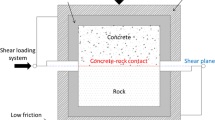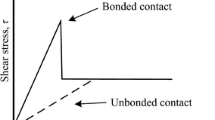Abstract
The interface behavior of rock and concrete and between layers of concrete highly affects the performance of concrete dam structures. In this investigation, a modified direct shear test was implemented in the laboratory to evaluate the interface behavior between (1) rock and conventional vibrated concrete (CVC), (2) rock and roller compacted concrete (RCC), (3) CVC and RCC and (4) two layers of RCC. Series of in situ shear tests were also performed between rock and concrete. The friction angle and cohesion for all tested interface were determined and analyzed. The effect of uniaxial compressive strength (UCS) of concrete on the interface behavior was determined. Additionally, the effect of surface roughness on the interface behavior was studied by determining the joint roughness coefficient values. The rock-CVC interface had a higher shear strength than the rock-RCC interface and the RCC–RCC interface had a significantly higher cohesion than the CVC–RCC interface. The peak friction angle equation for the rock joints was verified for rock-concrete interfaces. The high shear stress at the interface increases the dissipated energy. Based on the investigation, the rock-CVC interface with the highest concrete UCS had the highest cohesion, shear strength, and dissipated energy among the laboratory rock-concrete interfaces.



















Similar content being viewed by others
Abbreviations
- \(c\) :
-
Cohesion in the shear tests (MPa)
- \(c_{peak}\) :
-
Peak cohesion in the shear tests (MPa)
- \(c _{{p{-}CVC}}\) :
-
Interface peak cohesion in the rock-CVC specimens (MPa)
- \(c_{{p {-} RCC}}\) :
-
Interface peak cohesion in the rock-RCC specimens (MPa)
- \(c_{residual}\) :
-
Residual cohesion in the shear tests (MPa)
- \(c_{t}\) :
-
Cohesion in triaxial compression test (MPa)
- D :
-
Diameter of the specimen (mm)
- E :
-
Young’s modulus of elasticity (GPa)
- \(f^{{\prime }} c _{CVC}\) :
-
CVC uniaxial compression strength (MPa)
- \(f^{{\prime }} c _{RCC}\) :
-
RCC uniaxial compression strength (MPa)
- G :
-
Modulus of rigidity (GPa)
- H :
-
Height of the specimen (mm)
- K :
-
Bulk modulus (GPa)
- L :
-
Thickness of the specimen in splitting tensile strength test (mm)
- \(L_{p}\) :
-
Compression pulse-travel distance (m)
- \(L_{s}\) :
-
Shear pulse-travel distance (m)
- m :
-
Mass (kg)
- P :
-
Maximum applied load in splitting tensile strength test (N)
- T :
-
Splitting tensile strength (MPa)
- \(T_{p}\) :
-
Compression effective pulse-travel time (s)
- \(T_{s}\) :
-
Shear effective pulse-travel time (s)
- V :
-
Volume (m3)
- \(V_{p}\) :
-
Compression velocity (m/s)
- \(V_{p cvc}\) :
-
CVC cylinders compression velocity (m/s)
- \(V_{p rcc}\) :
-
RCC cylinders compression velocity (m/s)
- \(V_{s}\) :
-
Shear velocity (m/s)
- α :
-
Angle between the imported shear force and horizontal direction in the in situ shear test (°)
- \(\delta p_{s}\) :
-
Shear load increment in each step in the in situ shear test (N)
- μ :
-
Poisson’s ratio
- ρ :
-
Density (kg/m3)
- \(\sigma\) :
-
Differential failure stress in triaxial compression test (MPa)
- \(\sigma_{n}\) :
-
Normal stress in the shear tests (MPa)
- \(\sigma_{1}\) :
-
Total failure stress in triaxial compression test (MPa)
- \(\sigma_{3}\) :
-
Confining stress in triaxial compression test (MPa)
- \(\varphi\) :
-
Friction angle in the shear test (°)
- \(\varphi_{b}\) :
-
Interface basic friction angle (°)
- \(\varphi_{peak}\) :
-
Peak friction angle in the shear test (°)
- \(\varphi_{residual}\) :
-
Residual friction angle in the shear test (°)
- \(\varphi_{t}\) :
-
Friction angle in triaxial compression test (°)
References
ACI (2002) Standard practice for selecting proportions for normal, heavyweight, and mass concrete ACI 2111-91 (Reapproved 2002). American Concrete Institute, Farmington Hills
Alangi SH, Nozhati S, Vazirizade SM (2018) Critical reliability slip surface in soil slope stability analysis using Monte Carlo simulation method. Int J Struct Integr 9(2):233–240. https://doi.org/10.1108/ijsi-06-2017-0035
Andjelkovic V, Pavlovic N, Lazarevic Z, Nedovic V (2015) Modelling of shear characteristics at the concrete–rock mass interface. Int J Rock Mech Min Sci 76:222–236. https://doi.org/10.1016/j.ijrmms.2015.03.024
ASTM (2001a) Standard test method for density (unit weight), yield, and air content (gravimetric) of concrete ASTM C 138/C 138M–01. ASTM, West Conshohocken, pp 1–4
ASTM (2001b) Standard test method for splitting tensile strength of intact rock core specimens ASTM D 3967–95a (Reapproved 2001). ASTM, West Conshohocken, pp 1–3
ASTM (2002a) Standard test method for in situ determination of direct shear strength of rock discontinuities ASTM D 4554–02. ASTM, West Conshohocken, pp 1–7
ASTM (2002b) Standard test method for performing laboratory direct shear strength tests of rock specimens under constant normal force ASTM D 5607–02. ASTM, West Conshohocken, pp 1–12
ASTM (2002c) Standard test method for pulse velocity through concrete ASTM C 597–02. ASTM, West Conshohocken, pp 1–4
ASTM (2003a) Standard practice for capping cylindrical concrete specimens ASTM C 617–98 (Reapproved 2003). ASTM, West Conshohocken, pp 1–5
ASTM (2003b) Standard specification for concrete aggregates ASTM C 33–03. ASTM, West Conshohocken, pp 1–11
ASTM (2003c) Standard test method for compressive strength of cylindrical concrete specimens ASTM C 39/C 39 M–03. ASTM, West Conshohocken, pp 1–5
ASTM (2003d) Standard test method for slump of hydraulic-cement concrete ASTM C 143/C 143 M–03. ASTM, West Conshohocken, pp 1–4
ASTM (2005) Standard practice for making roller-compacted concrete in cylinder molds using a vibrating table ASTM C 1176–05. ASTM, West Conshohocken, pp 1–4
ASTM (2008a) Standard test method for determining consistency and density of roller-compacted concrete using a vibrating table ASTM C1170/C1170M–08. ASTM, West Conshohocken, pp 1–5
ASTM (2008b) Standard Test Method for laboratory determination of pulse velocities and ultrasonic elastic constants of rock ASTM D 2845–08. ASTM, West Conshohocken, pp 1–7
ASTM (2014) Standard test methods for compressive strength and elastic moduli of intact rock core specimens under varying states of stress and temperatures ASTM D 7012–14. West Conshohocken, PA, pp 1–9
ASTM (2015) Standard guide for petrographic examination of dimension stone ASTM C 1721–15. West Conshohocken, PA, pp 1–5
Barla G, Robotti F, Vai L (2011) Revisiting large size direct shear testing of rock mass foundations. In: 6th international conference on dam engineering. Lisbon, Portugal.
Barton N (1976) The shear strength of rock and rock joints. Int J Rock Mech Min Sci Geomech Abstr 13(9):255–279. https://doi.org/10.1016/0148-9062(76)90003-6
Barton N (1978) Suggested methods for the quantitative description of discontinuities in rock masses. ISRM Int J Rock Mech Min Sci Geomech Abstr 15(6):319–368. https://doi.org/10.1016/0148-9062(79)91476-1
Barton N, Choubey V (1977) The shear strength of rock joints in theory and practice. Rock Mech Rock Eng 10(1):1–54. https://doi.org/10.1007/BF01261801
Desai CS (2001) Mechanics of materials and interfaces: the disturbed state concept. CRC Press, Boca Raton
Desai CS, Zaman M (2014) Advanced geotechnical engineering: soil-structure interaction using computer and material models. CRC Press, Boca Raton
Ding X, Zhang L (2014) A new contact model to improve the simulated ratio of unconfined compressive strength to tensile strength in bonded particle models. Int J Rock Mech Min Sci 69:111–119. https://doi.org/10.1016/j.ijrmms.2014.03.008
Fronteddu L, Leger P, Tinawe R (1998) Static and dynamic behavior of concrete lift joint interfaces. J Struct Eng 124(12):1–13. https://doi.org/10.1061/(asce)0733-9445(1998)124:12(1418)
Ghosh A (2010) Shear strength of dam-foundations rock interface-a case study. In: Annual conference of Indian geotechnical society. Umbai, Maharashtra, India
Gu XF, Seidel JP, Haberfield CM (2003) Direct shear test of sandstone-concrete joints. Int J Geomech 3(1):21–33. https://doi.org/10.1061/(asce)1532-3641(2003)3:1(21)
Haberfield CM, Seidel JP (1999) Some recent advances in the modelling of soft rock joints in direct shear. Geotech Geol Eng 17(3):177–195. https://doi.org/10.1023/a:1008900905076
Heidarnezhad F, Toufigh V, Ghaemian M (2021) Analyzing and predicting permeability coefficient of roller-compacted concrete (RCC). J Test Eval Adv Online Publ. https://doi.org/10.1520/jte20180718
Hosseinali M, Toufigh V (2018) A plasticity-based constitutive model for the behavior of soil-structure interfaces under cyclic loading. Transp Geotech 14:41–51. https://doi.org/10.1016/j.trgeo.2017.10.001
Indraratna B, Haque A, Aziz N (1998) Laboratory modelling of shear behaviour of soft joints under constant normal stiffness conditions. Geotech Geol Eng 16(1):17–44. https://doi.org/10.1023/a:1008880112926
ISRM (1977) Suggested method for petrographic description of rocks. International society for rock mechanics. commission on standardization of laboratory and field Tests. Committee on laboratory tests, p 5
ISRM (1981) Suggested methods for determing shear strength. Part 1. Suggested method for in situ determination of direct shear strength International society for rock mechanics. Commission on standardization of laboratory and field Tests. Committee on laboratory tests, pp 131–135
Kodikara JK, Johnston IW (1994) Shear behaviour of irregular triangular rock-concrete joints. Int J Rock Mech Min Sci Geomech Abstr 31(4):313–322. https://doi.org/10.1016/0148-9062(94)90900-8
Krounis A, Johansson F, Larsson S (2016) Shear strength of partially bonded concrete–rock interfaces for application in dam stability analyses. Rock Mech Rock Eng 49(7):2711–2722. https://doi.org/10.1007/s00603-016-0962-8
Lam TSK, Johnston IW (1989) Shear behavior of regular triangular concrete/rock joints-evaluation. J Geotech Eng 115(5):728–740. https://doi.org/10.1061/(asce)0733-9410(1989)115:5(728)
Liu G, Lu W, Lou Y, Pan W, Wang Z (2018) Interlayer shear strength of Roller compacted concrete (RCC) with various interlayer treatments. Constr Build Mater 166:647–656. https://doi.org/10.1016/j.conbuildmat.2018.01.110
Lo KY, Ogawa T, Lukajic B, Dupak DD (1991) Measurements of strength parameters of concrete-rock contact at the dam-foundation Interface. Geotech Test J 14(4):383–394. https://doi.org/10.1520/gtj10206j
Lu Y, Wang L, Li Z, Sun H (2017) Experimental study on the shear behavior of regular sandstone joints filled with cement grout. Rock Mech Rock Eng 50(5):1321–1336. https://doi.org/10.1007/s00603-016-1154-2
Mouzannar H, Bost M, Leroux M, Virely D (2017) Experimental study of the shear strength of bonded concrete–rock interfaces: surface morphology and scale effect. Rock Mech Rock Eng 50(10):2601–2625. https://doi.org/10.1007/s00603-017-1259-2
Nasir O, Fall M (2008) Shear behaviour of cemented pastefill-rock interfaces. Eng Geol 101(3–4):146–153. https://doi.org/10.1016/j.enggeo.2008.04.010
Saiang D, Malmgren L, Nordlund E (2005) Laboratory tests on shotcrete-rock joints in direct shear, tension and compression. Rock Mech Rock Eng 38(4):275–297. https://doi.org/10.1007/s00603-005-0055-6
Seidel JP, Haberfield CM (2002) Laboratory testing of concrete-rock joints in constant normal stiffness direct shear. Geotech Test J 25(4):391–404. https://doi.org/10.1520/gtj11292j
Sotoudeh P, Ghaemian M, Mohammadnezhad H (2019) Seismic analysis of reservoir-gravity dam-massed layered foundation system due to vertically propagating earthquake. Soil Dyn Earthq Eng 116:174–184. https://doi.org/10.1016/j.soildyn.2018.09.041
Tian HM, Chen WZ, Yang DS, Yang JP (2015) Experimental and numerical analysis of the shear behaviour of cemented concrete–rock joints. Rock Mech Rock Eng 48(1):213–222. https://doi.org/10.1007/s00603-014-0560-6
Toufigh V, Desai CS, Saadatmanesh H, Toufigh V, Ahmari S, Kabiri E (2013) Constitutive modeling and testing of interface between backfill soil and fiber-reinforced polymer. Int J Geomech 14(3):04014009. https://doi.org/10.1061/(asce)gm.1943-5622.0000298
Toufigh V, Shirkhorshidi SM, Hosseinali M (2016) Experimental investigation and constitutive modeling of polymer concrete and sand interface. Int J Geomech 17(1):04016043. https://doi.org/10.1061/(asce)gm.1943-5622.0000695
U.S. Army manual (2000) Engineering and design roller-compacted concrete. EM 1110-2-2006. U.S. Army Corps of Engineers, Washington, DC
Zhang Q-Q, Feng R-F, Xu Z-H, Liu S-W, Qian J-G (2019) Evaluation of ultimate pullout capacity of anchor cables embedded in rock using a unified rupture shape model. Geotech Geol Eng 37(4):2625–2637. https://doi.org/10.1007/s10706-018-00782-0
Acknowledgements
The authors would like to thank Khakazma Company for providing the equipment for the experimental parts. The authors also greatly appreciate the support of Mr. Ali Naeeji and Ms. Elham Ghochi Asl for their kind help in the experimental programs and the petrographic description, respectively. The authors gratefully acknowledge Professor Chandrakant S. Desai and Professor Lianyang Zhang’s insightful comments and revision on this paper.
Author information
Authors and Affiliations
Corresponding author
Additional information
Publisher's Note
Springer Nature remains neutral with regard to jurisdictional claims in published maps and institutional affiliations.
Rights and permissions
About this article
Cite this article
Soltanianfard, M.A., Toufigh, V. & Ghaemian, M. The Interface Behavior of Rock, Conventional Vibrated and Roller Compacted Concrete. Geotech Geol Eng 38, 1949–1969 (2020). https://doi.org/10.1007/s10706-019-01141-3
Received:
Accepted:
Published:
Issue Date:
DOI: https://doi.org/10.1007/s10706-019-01141-3




